
How is Information Technology Rapidly Changing Business Today and in the Future?
Introduction
NTT DATA Technology Foresight acts as a compass, observing the current state of businesses that achieve continued growth through the maximum utilization of IT. In this article, Hiroshi Tomiyasu takes us through the NTT DATA Technology Foresight 2023.
Speaker Profile: Hiroshi Tomiyasu, General Manager of the NTT DATA Technology Innovation Division, is responsible for formulating R&D strategies, developing new technology offerings, and applying its IT assets to support the company and its clients globally. With a deep experience and expertise in software engineering and the development of platform technologies, he has led teams to deliver high-value outcomes and help clients transform their businesses.
This article is adapted from a sharing by Hiroshi Tomiyasu.
How is Information Technology Rapidly Changing Business Today and in the Future?
Technology Foresight 2023
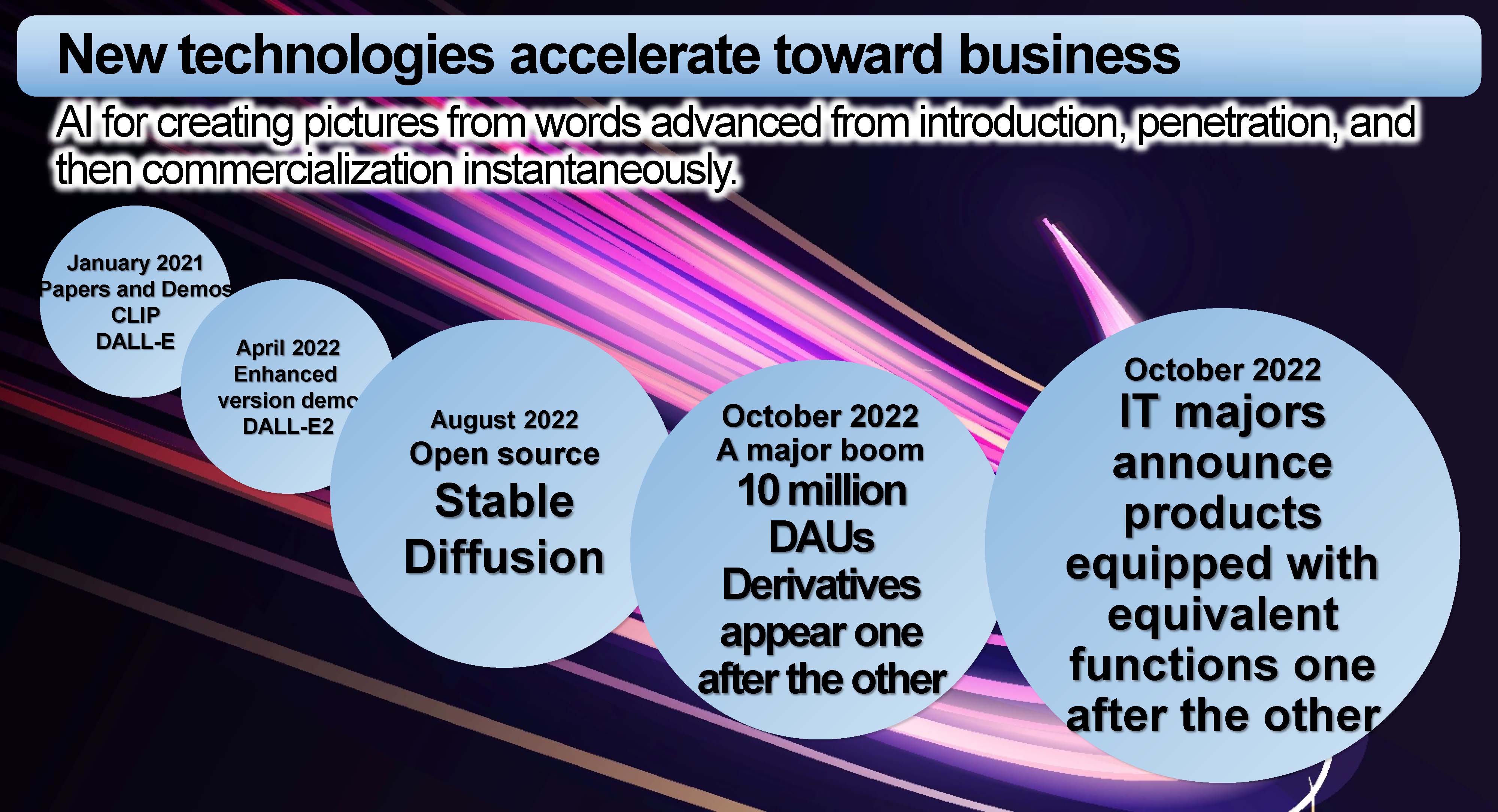
Technology continues to grow at unprecedented speeds. Even just glancing at the recent events of AI art, we can see how quickly new technology is being created, spread, and then utilized globally. The technology was introduced in January 2021 as part of an academic paper. Over the next year, additional technology was integrated and improved in quality, developing a publicly available website with open-source in August 2022. With only a brief sentence, users could create a never-before-seen image. Daily users exceeded 10 million within months, with many posting their creations to social media. With such rapid expansion and technological improvements, concerns about artists may be losing their jobs to AI have arisen. Some fears also stemmed from monetizing the art, due to the potential copyright issues of the original used. However, as companies raced to catch up with the technology, the declaration that AI art would support, rather than replace, individuals who draw and create, was made to temper these worries.
AI is just one of the latest technological trends that NTT DATA is actively researching and analyzing based on its accumulated expertise over the years.
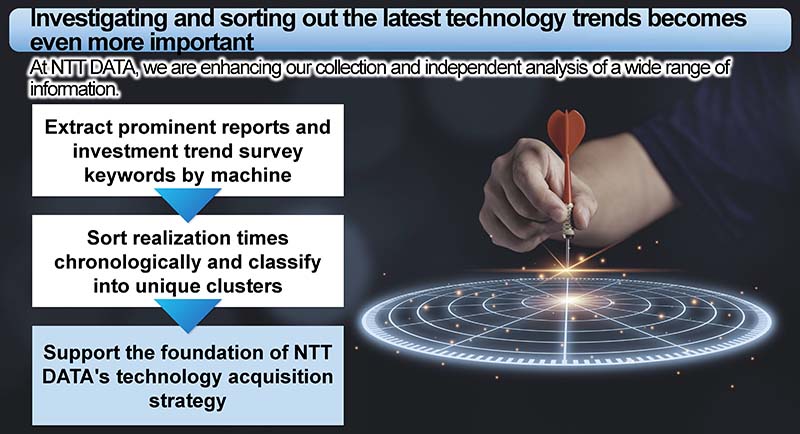
The visual above is an analysis chart of research result from NTT DATA's program that analyzes and categorizes a variety of data, including several well-known research reports and investment trends, and organizes them into a timeline of when the technology will be put to practical use and when it will impact business.
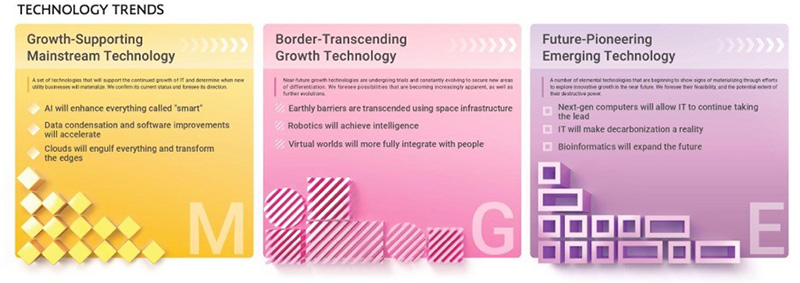
The Emerging Growth Mainstream (EGM) framework categorizes technologies by time. Under this EGM framework, the 'Mainstream' comprises technologies that can be applied to business today or soon; 'Growth' technologies will be applied to business in five years; and 'Emerging' technologies will be implemented in 10 years. With the EGM, NTT DATA forecasts the feasibility, growth potential, and timing of market entry for each technology before acquiring and investing in these technologies.
NTT DATA Technology Foresight ,with the EGM framework, consolidates information collection and analysis that forms the core of NTT DATA's technology strategy, providing a compass and basis for discussing the future and strategies with customers.

NTT DATA has identified IT-driven growth as a leading theme in this edition, assessing business growth driven by IT and its competitive capabilities. We then look at how IT enables the crossing of borders - how IT initiatives are poised to advance in the future, birthing new types of business alliances and transformations that smash the current lines drawn between business categories and industries. Finally, in our glimpse into 'The Future of IT,' we see how an IT-driven society presents new obstacles as technology evolves with massive increases in data quantity surrounding IT's core role in societal infrastructure.
Growth-Supporting Mainstream Technology
Let us first look at some upcoming, Mainstream technology beginning with:
The Cloud
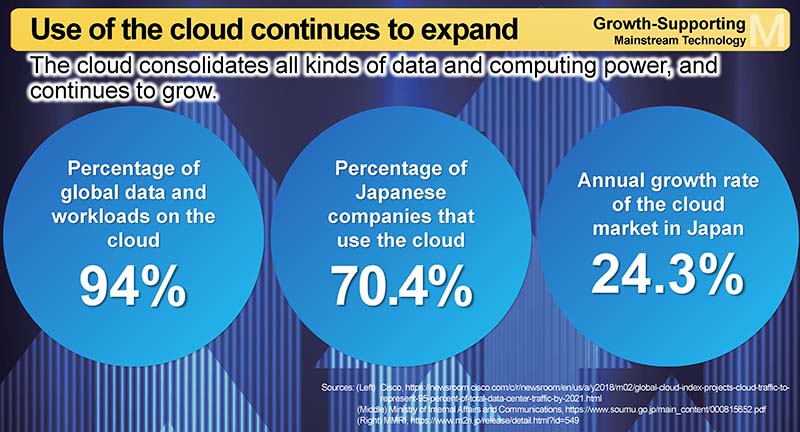
"The Cloud engulfs everything, and the edge is transformed."
In NTT DATA's observations, a growing trend in mainstream technology is the increase in Cloud usage, with the Cloud currently storing and processing 94% of the world's data and workloads.
For now, the Cloud is the go-to solution to store enterprises' ever-increasing quantities of data - given its scalability compared to on-premises alternatives. The Cloud forms a fine foundation upon which enterprises can onboard new emerging technologies. Cloud vendors have leveled up their capabilities beyond mere CPU storage, offering packages for a wide range of corporate uses such as customer administration, logistics management, and digital twin development - technology that aims to replicate physical environments into virtual ones.
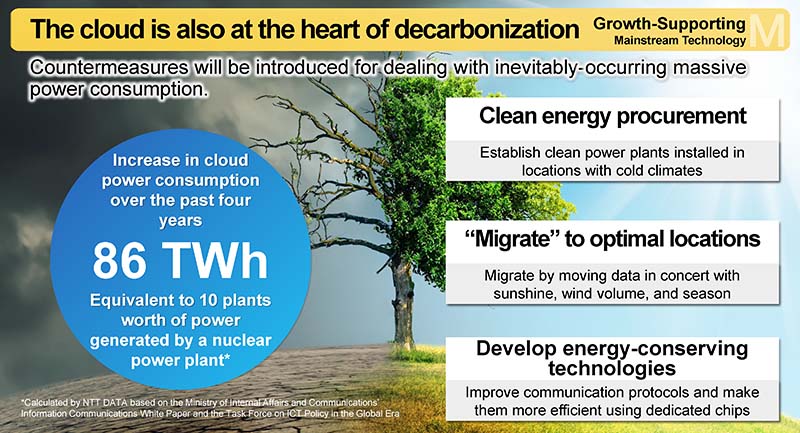
Of course, the power of the Cloud must be powered by electricity - and plenty of it. Over the last four years, the Cloud has consumed 86 terawatt-hours of energy - approximately ten times the annual electrical output of a single nuclear power plant.
Cloud vendors are starting to make more responsible moves for global decarbonization, pursuing a variety of clean energy projects, such as obtaining renewable energy and exhaustively investigating strategies to reduce electricity consumption. Data and workloads are also being relocated to regions where natural energy is available for use, such as sunny and windy locations with solar and wind farms, to enhance the Cloud's global network, leveraging technology once more to drive these initiatives.
Another noteworthy Cloud development is data sovereignty. The Cloud and the data it holds cross over borders, but are they subject to the sovereignty of the individual countries they are stored, processed, and used in? Governments worldwide are building legal systems to safeguard their citizens' data to ensure economic security. The movement critically examines hardware, software, and operational procedures to manage data that enters and exits the system appropriately with guaranteed, reliable security.
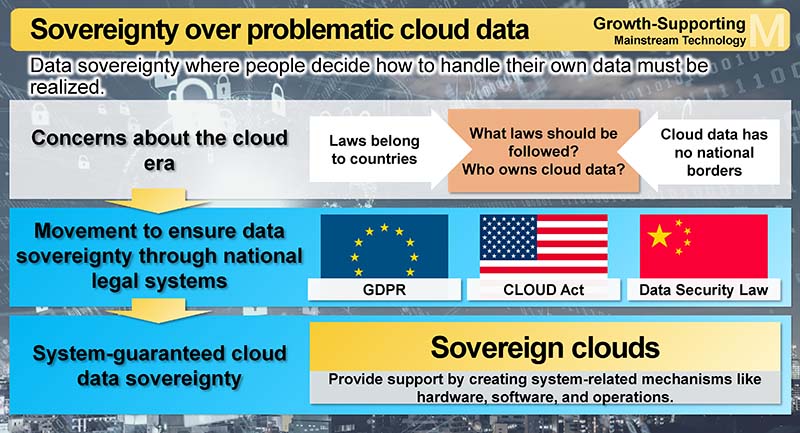
NTT DATA is collaborating with several clients to determine the specific requirements for such a Sovereign Cloud. It will collaborate with NTT Laboratories to build the relevant mechanisms required, such as access control, confidential data protection, management software development, and even plan major organizational schemes.
The Edge
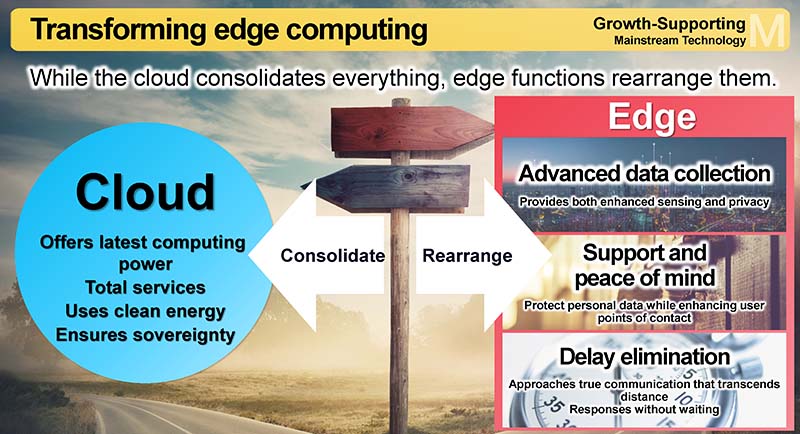
However, there remains an area where the Cloud cannot be used - the Edge, or the area outside the Cloud where data is generated and used. Reorganizing Edge Cloud requires advanced data collection, support and security, and elimination of delays.
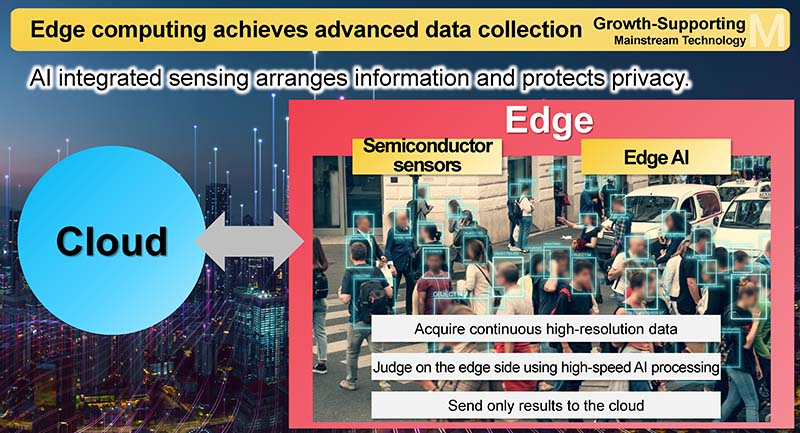
The Edge Computing can support advanced data collection with facilities immediately detecting anomalies while analyzing images acquired by sensors on AI computers. This is an effective approach that also answers privacy concerns because all records are securely stored in the Cloud.
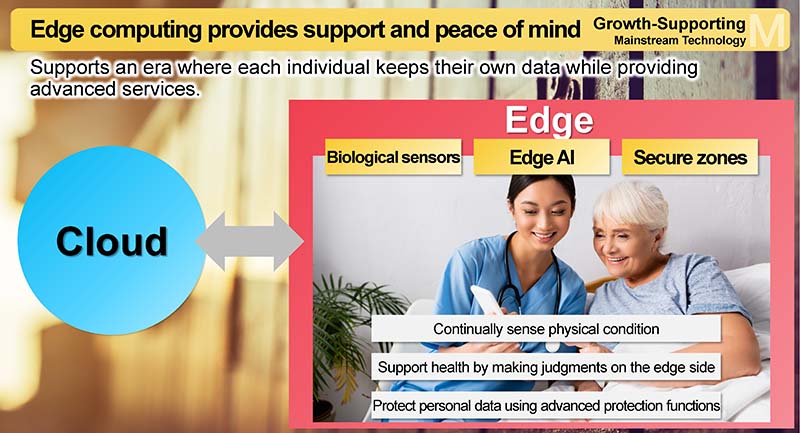
Next, the Edge Computing provides support and peace of mind by managing human biometric data. Wearable gadgets capture data such as sleep, temperature, pulse, and more without inflicting harm on the body - data sorted by Edge technology.
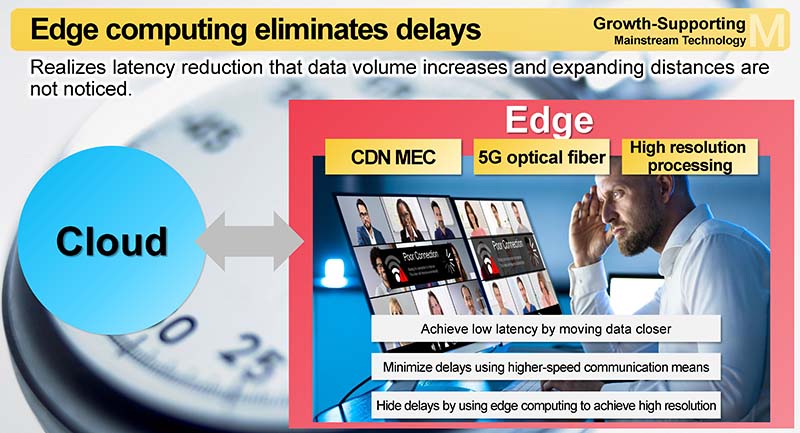
The Edge Computing also helps eliminate latency, such as that commonly seen in our day-to-day during online conferences, where a one-second delay in audio time can disrupt a seamless dialogue. In the bigger picture, latency forms the greatest adversary of the future's deeper data interchange, 3D interfaces, and natural interaction.
Contents Delivery Network (CDN) and Multi-access Edge Computing (MEC) have surfaced as solutions to latency by reducing the distance between the Cloud and your smartphone through another device as a go-between. As well as this, 5G optical communications can also help to reduce latency, while utilizing Edge technology will also allow high-resolution processing, which transfers coarse images with a minimal delay before reconstructing them in high resolution at the Edge.
Emerging Technologies in the Near Future
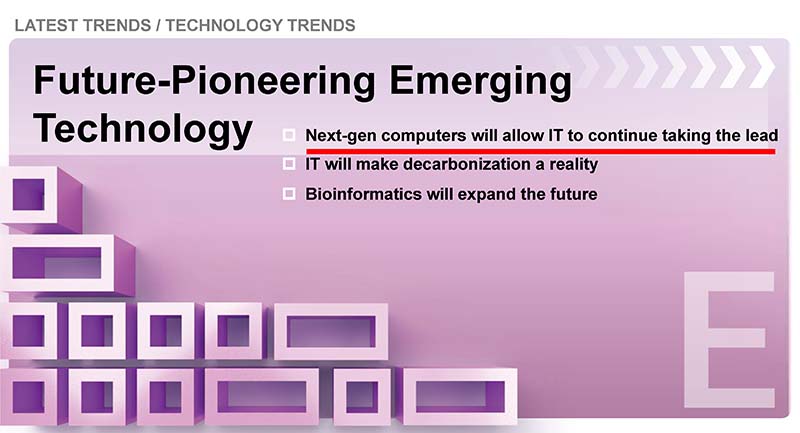
We turn our attention to semiconductors - the core of computers that governs IT capabilities. A company's competitiveness is increasingly relevant to its semiconductor design capabilities - as more corporations are designing their own semiconductor chips.
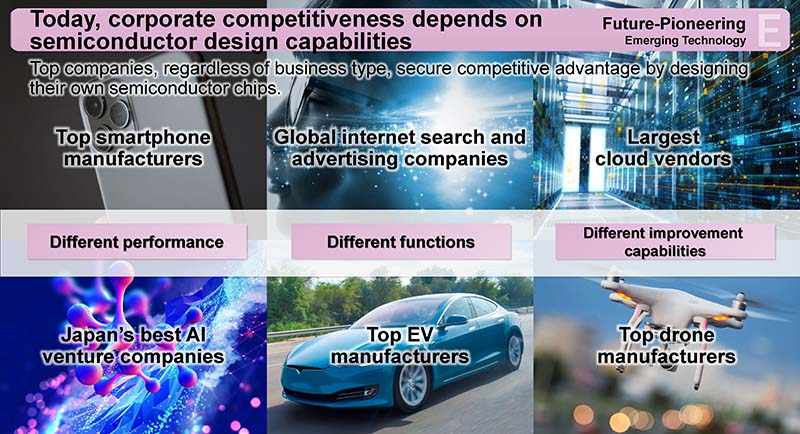
While more top businesses are building their own semiconductor chips to add differentiation, semiconductor capabilities remain limited in businesses today. While digital twin, autonomous automated driving, and the metaverse are all promising future technology and businesses, companies have yet to develop semiconductor capabilities with the adequate capacity to see these future technologies through to the fruition of their full potential.
An example of lacking power would be the EU's digital twin endeavor which looks to replicate the whole world in data, divided into 1 km squares - an exascale computing operation that demands one exaFLOP of performance, a simply staggering requirement. Such capability can only be obtained by occupying the world's top supercomputers.
However, there have been several breakthroughs in semiconductor manufacturing technology, such as miniaturization, chiplets and the introduction of novel materials and processes. Historically, this semiconductor technology has had a 20% annual performance increase. Despite that, NTT DATA estimates that semiconductor growth has slowed to 10% in recent years amidst complicated circumstances. Furthermore, the development costs needed to improve performance are becoming prohibitively expensive.
Quantum Computing
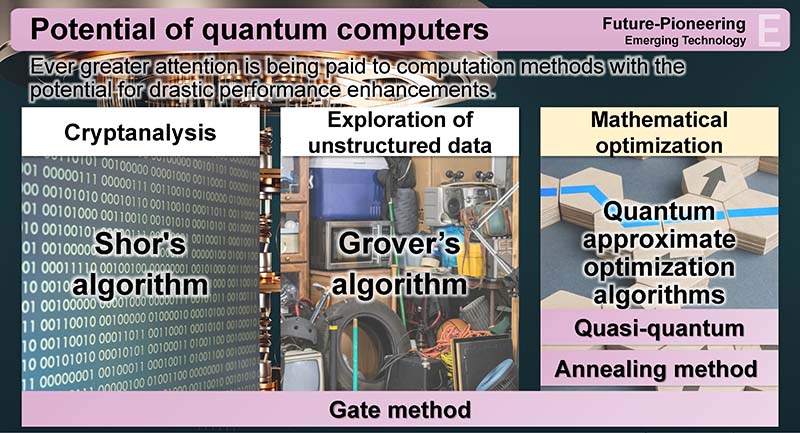
Under these challenging conditions, quantum computers, on the other hand, are expected to dramatically improve technological performance. Forecasted to be ready for practical usage in 10 to 20 years for specialized purposes, quantum computers are touted to outperform existing computers, especially in three specific areas:
First is Cryptanalysis, where a reasonably fast quantum computer can be expected to decipher the commonly used RSA encryption.
Second is the search for unstructured data - or finding a hit in miscellaneous data rather than a collection of information that can be summarized in a table and achieved at lightning speed with a quantum computer.
Third is mathematical optimization, which can help with what is otherwise known as the "traveling salesman." This looks to find the most optimal object from a set of objects, for example the optimal routing between a number of cities, or scheduling the best date.
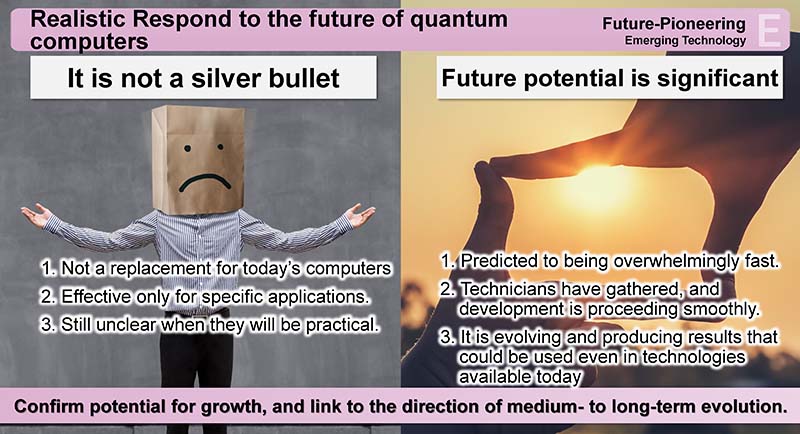
However, several hurdles are delaying the advent of this purportedly revolutionary quantum computer. Such computing can only ever be used for specific tasks and will not replace the computers we use at home; as such, it has yet to be discovered when such computing will become commercialized.
Nonetheless, we can expect quantum computers to eventually be far quicker than modern computers in specific applications that they are gated to perform. As we chase the promise of this potential, the Quantum Computer Department has attracted a large number of engineers, as well as math and physics specialists, with substantial research and development activities ongoing through recurring venture capital investments.
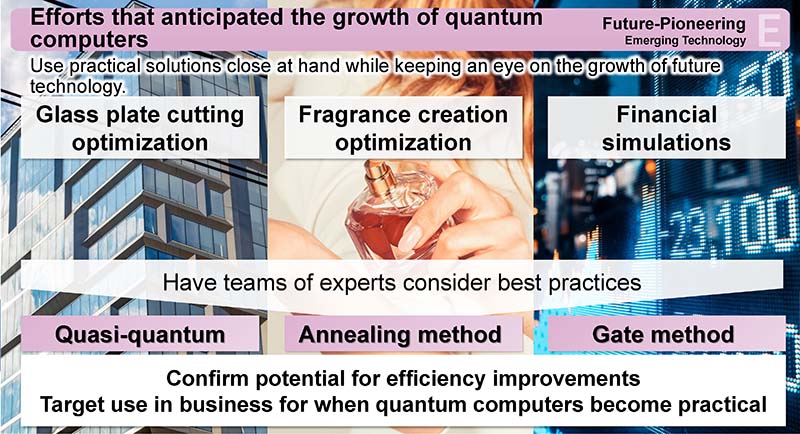
Here at NTT DATA, we are also keeping an eye on the development of quantum computing technology by conducting various trials and implementing a quantum computer to respond to client consultation. NTT DATA has employed quantum computing techniques to solve real-world problems like determining the most efficient method to cut numerous pieces of glass from a single large glass pan.
In each of these circumstances, NTT has recognized that present-day computers have limited ability to tackle the challenges of today. This begs the question, will quantum computers be able to solve the problems that we will face in the future?
NTT DATA's team of professionals selectively employs various methods such as pseudo-quantum, annealing, and gating methods, while exploring the possibility of strengthening the company by utilizing future quantum computing technologies. The plan is to prepare now rather than wait for the hardware to be ready.
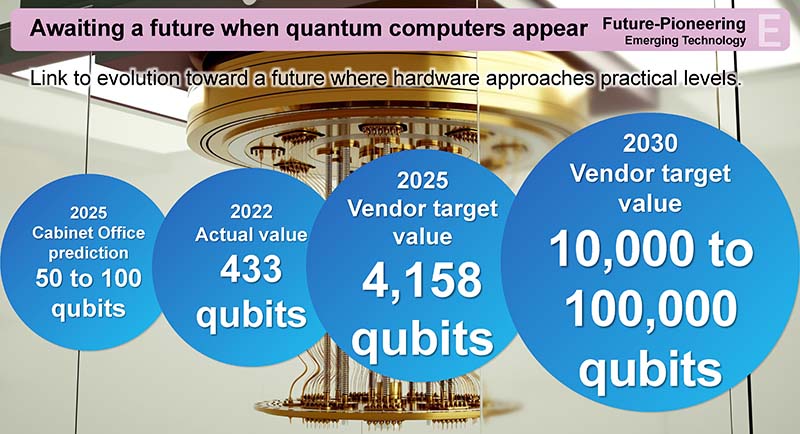
Encouragingly, quantum computer development is said to be moving quicker than expected, with predictions that the number of qubits (a unit of quantum information) of quantum computers will increase from 50 to 109 bits by 2025. We have even seen a vendor develop a gated quantum computer that has achieved 433 qubits in 2022, exceeding the forecast. This vendor's goal is to exceed 4158 qubits by 2025 and 10,000 qubits by 2030 - meaning that the 10,000 number, which is the minimum for a quantum computer to deliver realistic results, is coming to fruition. The daily challenge of continuously synchronizing with technological growth is becoming increasingly worthwhile.
Summary
It is necessary to be proactive in exploring the relevant facets of our accelerated technology evolution and grow increasingly proactive in the face of IT transformation.
Another takeaway from our review of Cloud and Edge trends is that the seemingly complex and disjointed technological evolution we see has an overarching direction or trend. This evolution is in sync with business and each advancement moves to facilitate the next trend in business.
Finally, it is paramount that we emplace strategies for medium and long-term technological progress. NTT DATA has demonstrated with its work on quantum computers that even if the requisite technology is only viable beyond a 10- or 20-year horizon, we should still seek to gain a competitive edge in business by embracing it now.
While some wait for evolution to materialize, the competition has begun during this waiting time. The impact of IT on business will only grow in the future and we need more aggressive measures to cope with technological growth. NTT DATA would like to continue to discuss future IT strategies to align with this growth with our customers in the NTT DATA Technology Foresight.
This article was created by the NTT DATA Focus edit team based on a speech given at the NTT DATA Innovation Conference 2023, held on January 24 and 25, 2023.